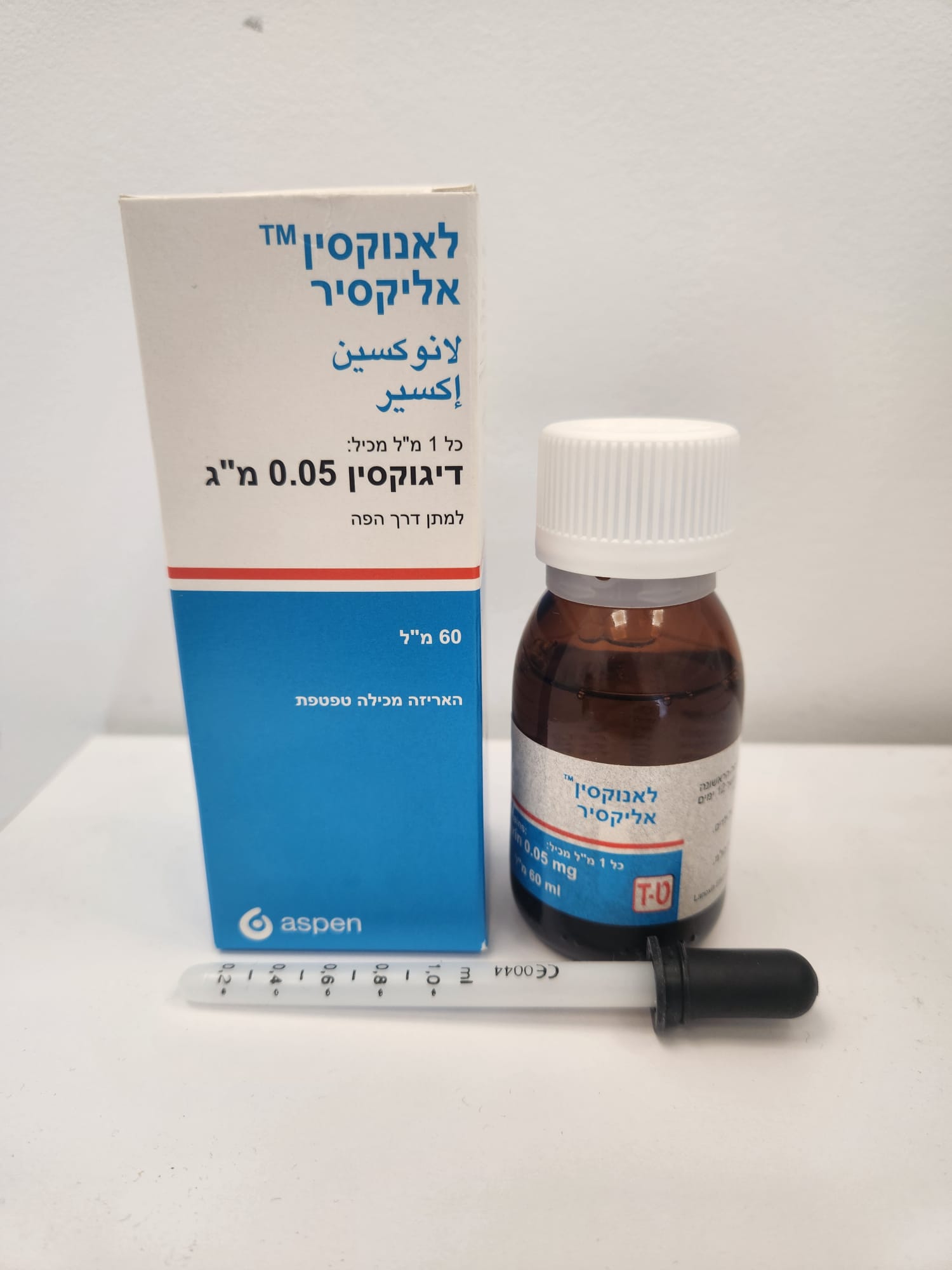Quest for the right Drug

לאנוקסין אליקסיר LANOXIN ELIXIR (DIGOXIN)
תרופה במרשם
תרופה בסל
נרקוטיקה
ציטוטוקסיקה
צורת מתן:
פומי : PER OS
צורת מינון:
תמיסה אלכוהולית : ELIXIR
עלון לרופא
מינוניםPosology התוויות
Indications תופעות לוואי
Adverse reactions התוויות נגד
Contraindications אינטראקציות
Interactions מינון יתר
Overdose הריון/הנקה
Pregnancy & Lactation אוכלוסיות מיוחדות
Special populations תכונות פרמקולוגיות
Pharmacological properties מידע רוקחי
Pharmaceutical particulars אזהרת שימוש
Special Warning עלון לרופא
Physicians Leaflet
Interactions : אינטראקציות
4.5. Interaction with other medicinal products and other forms of interaction These may arise from effects on the renal excretion, tissue binding, plasma protein binding, distribution within the body, gut absorptive capacity, P-glycoprotein activity and sensitivity to digoxin. Consideration of the possibility of an interaction whenever concomitant therapy is contemplated is the best precaution and a check on serum digoxin concentration is recommended when any doubt exists. Digoxin is a substrate of P-glycoprotein. Thus, inhibitors of P-glycoprotein may increase blood concentrations of digoxin by enhancing its absorption and/or by reducing its renal clearance (see Section 5.2). Induction of P-glycoprotein can result in decreases in plasma concentrations of digoxin. Combinations that should be avoided Combinations which can increase effects of digoxin when co-administered: Digoxin, in association with beta-adrenoceptor blocking drugs, may increase atrio-ventricular conduction time. Agents causing hypokalaemia or intracellular potassium deficiency may cause increased sensitivity to digoxin; they include lithium salts, corticosteroids,carbenoxolone and some diuretics. Co- administration with diuretics such as loop or hydrochlorothiazide should be under close monitoring of serum electrolytes and renal function. Calcium, particularly if administered rapidly by the I.V. route, may produce serious arrhythmias in digitalized patients. Sympathomimetic drugs have direct positive chronotropic effects that can promote cardiac arrhythmias and may also lead to hypokalaemia, which can lead to or worsen cardiac arrhythmias. Concomitant use of digoxin and sympathomimetics may increase the risk of cardiac arrhythmias. Combinations requiring caution Combinations which can increase the effects of digoxin when co-administered:amiodarone, canagliflozin, daclatasvir, flibanserin, flecainide, prazosin, propafenone, quinidine, spironolactone, macrolide antibiotics e.g. erythromycin and clarythromycin, tetracycline (and possibly other antibiotics), gentamicin, isavuconazole, itraconazole, ivacaftor, quinine, trimethoprim, alprazolam, indomethacin, propantheline, mirabegron, nefazodone, atorvastatin, cyclosporine, epoprostenol (transient), vasopressin receptor antagonists (tolvaptan and conivaptan), carvedilol, ritonavir/ritonavir containing regimens, taleprevir, dronedarone, ranolazine, simeprevir, telmisartan, lapatinib, ticagrelor, vandetanib, velpatasvir, venetoclax and vemurafenib. Care should be taken when any of the above medicinal products are used in combination with digoxin. Serum digoxin concentrations should be monitored and used for titration of digoxin. The concomitant use of digoxin and sennosides may be associated with a moderate increase in the risk of digoxin toxicity in heart failure patients. Patients receiving digoxin are more susceptible to the effects of suxamethonium-exacerbated hyperkalaemia. Co-administration of lapatinib with orally administered digoxin resulted in an increase in the AUC of digoxin. Caution should be exercised when dosing digoxin concurrently with lapatinib. Drugs that modify afferent and efferent arteriole vascular tone may alter glomerular filtration. Angiotensin converting enzyme inhibitors (ACEIs) and angiotensin receptor blockers (ARBs) decrease angiotensin II-mediated efferent arteriole vasoconstriction, while non-steroidal anti- inflammatory drugs (NSAIDs) and cyclooxygenase-2 enzyme (COX-2) inhibitors decrease prostaglandin-mediated afferent arteriole vasodilation. ARBs, ACEIs, NSAIDs, and COX-2 inhibitors did not significantly alter digoxin pharmacokinetics or did not alter PK parameters in a consistent manner. However, these drugs may modify renal function in some patients, resulting in a secondary increase in digoxin. Calcium channel blocking agents may either increase or cause no change in serum digoxin levels. Verapamil, felodipine and tiapamil increase serum digoxin levels. Nifedipine and diltiazem may increase or have no effect on serum digoxin levels while isradipine causes no change. Calcium channel blockers are also known to have depressant effects on sinoatrial and atrioventricular nodal conduction, particularly diltiazem and verapamil. Proton pump inhibitors (PPI) are able to increase plasma levels of digoxin by inhibiting its efflux. Metabolism of digoxin in the gastrointestinal tract is inhibited by omeprazole, resulting in increased plasma levels of digoxin. Similar effects have been reported with pantoprazole and rabeprazole to a lesser extent. Combinations which can decrease the effects of digoxin when co-administered: antacids, some bulk laxatives, kaolin-pectin, acarbose, neomycin, penicillamine, rifampicin, some cytostatics, metoclopramide, sulfasalazine, adrenaline, salbutamol, cholestyramine, phenytoin, St John’s wort (Hypericum perforatum), bupropion and supplemental enteral nutrition. Bupropion and its major circulating metabolite, with and without digoxin, stimulated OATP4C1- mediated digoxin transport. Digoxin has been identified as a substrate for aOATP4C1 in the basolateral side of the proximal renal tubules. Binding of bupropion and its metabolites to OATP4C1 could possibly increase the transport of digoxin and therefore, increase the renal secretion of digoxin. Other interactions Milrinone does not alter steady-state serum digoxin levels

שימוש לפי פנקס קופ''ח כללית 1994
Congestive heart failure, pulmonary edema, acute and chronic atrial fibrillation and flutter, other supraventricular arrhythmias
תאריך הכללה מקורי בסל
01/01/1995
הגבלות
תרופה שאושרה לשימוש כללי בקופ'ח
מידע נוסף
